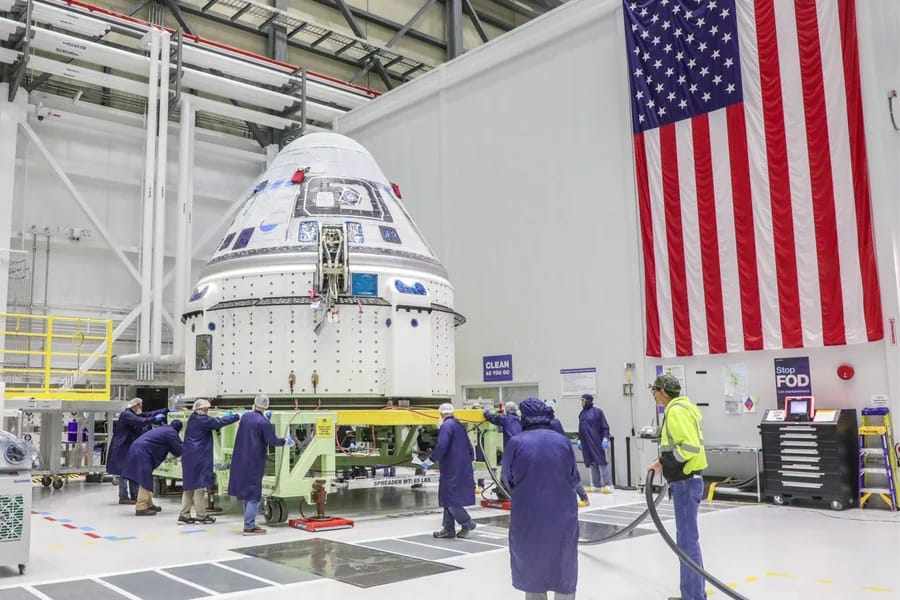- Weekly Dose of Random Knowledge
- Posts
- Boeing Starliner: What Went Wrong?
Boeing Starliner: What Went Wrong?
Consequences of Corporate Greed.
Hello Subscribers. Sorry for missing the past three weeks of the newsletter. It’s been hectic moving to college and starting a new school year. I hope you all are doing well.
Good news:
The record of the number of people in Earth's orbit has just been broken. Currently (Sep 12th, 2024) there are 19 people in the orbit. There are 12 people on the ISS (International Space Station), 3 people in China’s Tiangong space station, and four astronauts in the free flying Crew Dragon.
Bad news:
The only reason there are 12 and not 10 people on the ISS (as planned) is because Boeing Starliners failed the first crewed (crude) test. The space capsule gave the two astronauts a one way trip into space. It was lucky to land back in New Mexico earlier this week, but without the crews.
What Went Wrong Technically?
In this article, we are specifically going to cover what went wrong with the Boeing Starliner capsule that resulted in its malfunction. The two astronauts, Sunita Williams and Butch Wilmore, departed on June 5th, 2024, originally planned for a roughly 8 days mission. The faulty Starliner has forced these two astronauts to stay on the ISS until February of 2025, extending the trip from 8 days to 8 months. They will eventually return with the crew from the next mission, in a SpaceX Dragon.

Boeing Starliner’s crew module (on the top) and service module (bottom).
Starliner’s first crewed test was originally set to launch in 2017, after multiple delays in the testing stage (aka it had so many problems it couldn’t be launched), the launch date was then set to be May 6th, 2024. The launch failed due to problems with the oxygen valve and some helium leakage. However, it was said that the helium leakage wasn’t substantial enough to risk the mission. The second attempt to launch the rocket was on June 1st. The launch was unsuccessful again due to some ground computer hardware fault. Finally, after two failed attempts, they launched the Starliner on June 5th, 2024.
Listen, Boeing was supposed to deliver a working Crew Space Transportation (CST) System in 2017. They received 4.2 Billion dollars of government funds to build that. What portion of that money actually went into the production process??
Problem 1: Thruster ineffective while docking
The first problem occurred when Suni and Butch were trying to dock the Starliner to the ISS. The Starliner’s Reaction Control System (RCS) in the service module consists of 24 vernier thrusters that are capable of producing a small amount of thrust to finetune the capsule’s position. These vernier thrusters are positioned all around the capsule to provide movement and rotation in any direction. While preparing to dock, five of the 24 thrusters stopped working, and five of the eight downward thrusters malfunctioned. This failure made it impossible to dock, but equally unlikely to return back to the atmosphere.
Fortunately, on the ground, the Boeing engineers were able to connect to the thrusters and fix four out of the five broken thrusters. After waiting for over an hour, Suni and Butch successfully docked onto the ISS. But they didn’t know exactly why the five thrusters failed, or how it magically started to function again. The unpredictability of the spacecraft is what makes it unsafe to fly back.
After two months of testing, Boeing concluded that the thruster failure was caused by the exposure of the Teflon seal to the propellant nitrogen tetroxide. The deformation of the Teflon seal resulted in less propellant in the combustion chamber than what the computer expected, therefore, it triggered a shutdown. As to why it came back up, they don’t know. Perhaps they will never know because the service module will be dissipated while re-entering the orbit, only the crew module will land on Earth.
The crewless crew module landed in New Mexico on Sept. 7th. During the re-entry to the atmosphere, the Starliner experienced a glitch in the navigation system and yet another, failed thruster.
Problem 2: Helium leakage
While the thruster disaster unfolded, a few additional helium leak was discovered. As mentioned before, there was already a helium leak discovered during the attempt to launch on May 6th. Two more leaks were reported during the flight to ISS, another was discovered while approaching the dock. The fifth one is discovered post-docking. The largest leak is at 395 psi per minute.
Helium is used in the spacecraft to push the propellants to the combustion system. Without enough helium, propellants are unusable. Helium is the ideal element in this situation because it’s lightweight and noninflammable.
Conclusion
This whole mission felt like driving a horribly maintained Mustang, it looks fancy, but something’s always breaking (I personally prefer my reliable Miata). Sure, we can’t expect a test flight to be perfect, but these series of problems revealed a deeper level of corruption within the company rather than just ‘bad engineering’. Boeing used to be driven by engineers, now they are run by Wall Street dudes who are willing to sacrifice anything for profit. Some suspect this shift in value started when Boeing purchased McDonnell Douglas in 1997. McDonnell Douglas’s company culture was said to be profit-driven, controlled, and lacked innovation. They say Boeing sold their souls to McDonnell Douglas with their own money. After 20+ years, Boeing has adopted McDonnell Douglas’s values and failed as a human-centered engineering company.